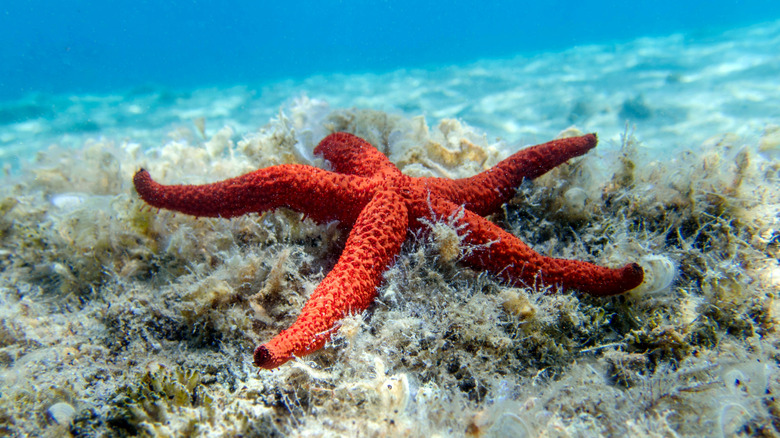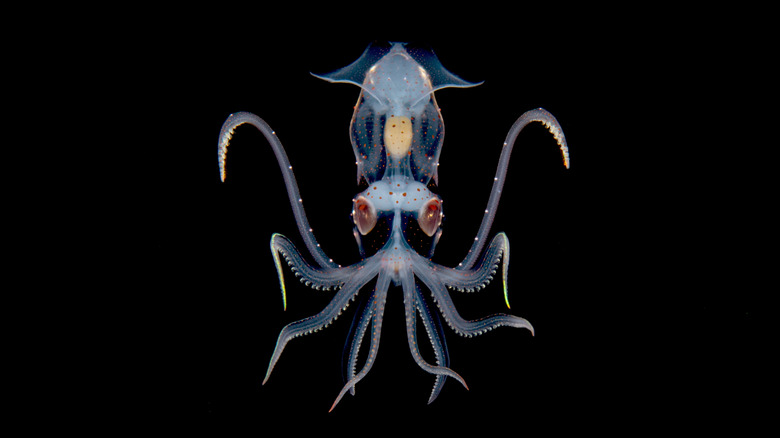Why Colors Change The Deeper You Swim In Water
We may receive a commission on purchases made from links.
The vacation to the Mediterranean you've been waiting for all year has finally arrived. You've made all the reservations, planned your sightseeing, and packed your bags. As you and your friends dive into the waves off the coast of Greece from the top of the boat you hired for the day, your friend snaps some underwater photos of the group with their GoPro Hero13. But when they show you the images, the vibrant red of that expensive new swimsuit you wanted to show off — the same swimsuit that looked so good in photos taken on the boat — looks dark and dull by comparison. What happened?
Your friend's camera is working just fine. This seeming optical illusion is actually just the result of physics at work in one of Earth's most fascinating environments. Water acts as a natural filter for light, progressively absorbing different colors at different depths. While sunlight contains the full rainbow of colors visible to humans, water molecules interact with these light waves in surprising ways, creating the underwater world's characteristic blue glow and causing objects with certain colors, like red and orange, to fade to grey or black the deeper you go.
This phenomenon affects everything from underwater photography to the evolution of deep-sea creatures. Diving deeper into the physics behind the visible reality reveals how fascinating properties of light waves create this underwater color shift and how marine life has adapted in remarkable ways to gain an advantage in the unforgiving aquatic ecosystem that is the deep ocean. From the specialized eyes of twilight zone dwellers to the strategic coloration of animals living in the lightless depths, the relationship between light, color, and water unveils nature's ingenious solutions to the challenges of living in an environment where colors aren't what they seem.
The science behind underwater color changes
When you look at a rainbow, you're seeing the full spectrum of visible light: red, orange, yellow, green, blue, and violet — famously acronymed as ROYGBV. Each color represents light waves with different wavelengths and energy levels. Red light waves, at one end of the spectrum, have the longest wavelengths, around 700 nanometers and the lowest energy (for reference, a piece of paper is roughly 100,000 nanometers thick). At around 500–400 nanometers, violet light waves are much shorter and pack considerably more energy. This difference in energy is the key to understanding why colors change underwater.
Water molecules are extraordinarily effective at absorbing light, but they don't absorb all colors equally. Think of water as a selective filter that removes colors one by one as light travels deeper. Red light, with its lower energy, gets absorbed first, disappearing within the first 15 to 20 feet of your dive. Orange and yellow follow, fading away as you descend beyond 30 feet. Green holds out until roughly 65 feet, while blue and deep violet, the highest energy light waves in the visible spectrum, reach depths of around 330 feet. This is why scuba divers and snorkelers see the sea bottom as a dark blue, it's the only light that can reach those depths.
This selective absorption explains why underwater photos often have a blue-green tint to them, and why that striking red swimsuit appears increasingly dark or grey as you dive deeper. Without red light waves reaching the swimsuit and reflecting back to your eyes or the camera, the color simply can't be seen. Professional underwater photographers understand this phenomenon well, often carrying specialized lights to restore the full color spectrum when filming at depth and utilizing editing techniques in post-production to achieve a more vibrant effect.
Biological adaptations to underwater light
The deeper you go in the water, the stranger things get (just see our list of the top 5 strangest sounds ever captured in the ocean if you need proof). Scientists have classified certain ocean depths according to how much light penetrates the water, which has a direct impact on the types of life that can exist there. The sunlit upper layer, called the euphotic zone, can extend down to 650 feet in open ocean. The dysphotic zone (also known as the twilight zone) ranges from approximately 650 to around 3,280 feet. After that, you're in the aphotic zone, a realm of complete darkness where sunlight never reaches. Even though there are characteristics that all fish have in common, these dramatically different light conditions have driven remarkably unique evolutionary adaptations among sea creatures.
In the twilight zone, many organisms have developed extraordinarily powerful eyes, some 10 to 100 times more sensitive to light than humans'. These specialized visual systems detect the faintest light filtering down from above. Other creatures have evolved massive eyes. The dinner-plate-sized eyes of the giant squid, for example, work like biological telescopes, gathering every possible photon. In the pitch-black aphotic zone, many species have abandoned vision entirely, developing enhanced systems of smell, touch, and the ability to detect minute changes in water flow instead.
Perhaps most fascinating is how deep-sea creatures use color strategically despite living in near or total darkness. Red animals dominate the deep ocean, appearing virtually invisible since no red light penetrates to their habitat. On the other end, some deep-sea organisms have evolved bioluminescence, producing their own light through chemical reactions. This self-generated illumination serves multiple purposes: attracting mates, luring prey, and confusing predators. And all of this is due to waves, either from the sun or the water itself.


